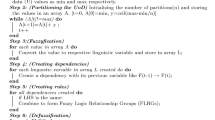Abstract
Potential output and output gap are important reference variables in economy cycle fluctuation. According to the situation, that measurement methods of potential output are numerous and independent, this article establishes the improvement method based on synthetically evaluation of fuzzy entropy. This method could produce discourse domain for different measurement results, calculate membership function value with the method of local replacement iteration, and determine the best time series of output gap. Empirical results shows, that the output gap of 1992Q1-2013Q3, which is obtained by the improvement method, is better than the estimated values of HP filtering method, production function method, and Vector auto-regression in terms of predictive ability of inflation, the agreement degree of factual economic cycle, and stability.
Similar content being viewed by others
Notes
- 1.
National Statistic Bureau of China, http://data.stats.gov.cn/workspace/index?m=hgjd.
- 2.
Data are published by Ministry of Human Resources and Social Security of China on quarterly press conference..
References
Tian, Q.S.: Analyzing issues of macroeconomic situation. J. Soc. Sci. Guangdong 2, 33–45 (2013)
Okun, A.M.: Potential GNP: its measurement and significance. In: Proceedings of the Business and Economics Statistics Section of the American Statistical Association (1962)
Cerra, V., Saxena, S.C.: Alternative Methods of Estimating Potential Output and the Output Gap-An Application to Sweden. International Monetary Fund, Washington (2000)
Liu, B., Zhang, H.Q.: The estimation of output gap in China. J. Fin. Res. 10, 69–77 (2001)
Guo, Q.W., Jia, J.X.: China economic fluctuation: the impact of investment and total factor productivity shock. J. Manage. World. 7, 22–28 (2004)
Zhang, H.W.: Output gap in China and to estimate the potential economic growth rate. J. Econ. Perspect. 8, 44–49 (2005)
Shi, Z.X., Huang, H.M., Shi, Q.H.: Empirical studies of China potential GDP, fluctuation and inflation. J. World Econ. 8, 34–41 (2004)
Zhao, Q.D.: Estimation of China output gap based on the Phillips curve. J. World Econ. 1, 57–64 (2008)
Guo, Q.W., Jia, J.X.: Estimating potential output and the output gap in China. J. Econ. Res. J. 5, 31–39 (2004)
Xu, Z.Y.: Estimating on China potential output and output gaps—by the method of Kalman filter. J. Quant. Tech. Econ. 12, 3–15 (2005)
Zhang, C.S.: Estimating output gap: a multivariate dynamic model approach. J. Stat. Res. 7, 27–33 (2009)
Zhao, Q.D., Gen, P.: Estimation method of state apace model using Bayesian Gibbs sampler and its application on estimating China’s potential growth. J. Stat. Res. 9, 55–63 (2009)
Yang, T.Y., Huang, S.F.: Estimating China’s output gap based on wavelet denoising and quarterly data. J. Econ. Res. J. 01, 115–126 (2010)
Zhen, T.G., Wang, X., Shu, N.: Real-time inflation forecasting and its applicability of Phillips curve to China. J. Econ. Res. J. 03, 88–101 (2012)
Huang, T., Yang, J.L., Jiang, M.Q.: The effect of inflation, the output gap and Chinese inflation outlook in 12th Five-Year Plan period. J. Macroecon. 04, 3–9 + 38 (2013)
Yan, S.B., Zhang, L.C.: The definition and measurement method of potential output and output gap. J. Cap. Univ. Econ. Bus. 01, 42–48 (2007)
Camba-Mendez, G., Rodriguez-Palenzuela, D.: Assessment criteria for output gap estimates. J. Econ. Model. 20(3), 529–562 (2003)
Xie, J.J., Liu, C.P.: The method of fuzzy mathematics and its applications, 3rd edn, pp. 29–37. Huazhong University of Science and Technology Press, Wuhan (2006)
Gong, L.T.: Optimization in Economics, pp. 65–67. Peking University Press, Beijing (2000)
Qian, S.D., et al.: Operations Research, pp. 136–178. Tsinghua University Press, Beijing (2000)
Ma, W.T., Wei, F.C.: Quarterly output gap measure based on the new Keynes dynamic stochastic general equilibrium model. J. Manage. World. 8, 39–65 (2011)
Fan, Q.: Details of perpetual inventory method and capital stock estimation of China from 1952 to 2009. J. Yunnan Univ. Fin. Econ. 3, 42–50 (2012)
Shan, H.J.: Reestimating the capital stock of China: 1952–2006. J. Quant. Tech. Econ. 10, 17–31 (2008)
Yang, G.Z., Li, H.J.: Potential output estimated with the production function method, the relationship between output gap and inflation: 1978–2009. J. Fin. Res. 3, 42–50 (2011)
An, L.R., Dong, L.D.: Research on the potential economic growth and natural employment based on capital-driven theory. J. Quant. Tech. Econ. 02, 99–112 (2011)
Guo, H.B., Chen, P.: The estimation and evaluation of China’s output gap based on the SVAR mode. J. Quant. Tech. Econ. 05, 116–128 (2010)
Wang, S.P., Hu, J.: Trend-cycle decomposition and stochastic impact effect of Chinese GDP. J. Econ. Res. J. 04, 65–76 (2009)
Author information
Authors and Affiliations
Corresponding author
Editor information
Editors and Affiliations
Rights and permissions
Copyright information
© 2016 Springer-Verlag Berlin Heidelberg
About this paper
Cite this paper
Chen, R. (2016). Measurement Method Improvement of China’s Potential Output: Based on the Synthetically Evaluation of Fuzzy Entropy. In: Bian, F., Xie, Y. (eds) Geo-Informatics in Resource Management and Sustainable Ecosystem. GRMSE 2015. Communications in Computer and Information Science, vol 569. Springer, Berlin, Heidelberg. https://doi.org/10.1007/978-3-662-49155-3_44
Download citation
DOI: https://doi.org/10.1007/978-3-662-49155-3_44
Published:
Publisher Name: Springer, Berlin, Heidelberg
Print ISBN: 978-3-662-49154-6
Online ISBN: 978-3-662-49155-3
eBook Packages: Computer ScienceComputer Science (R0)




